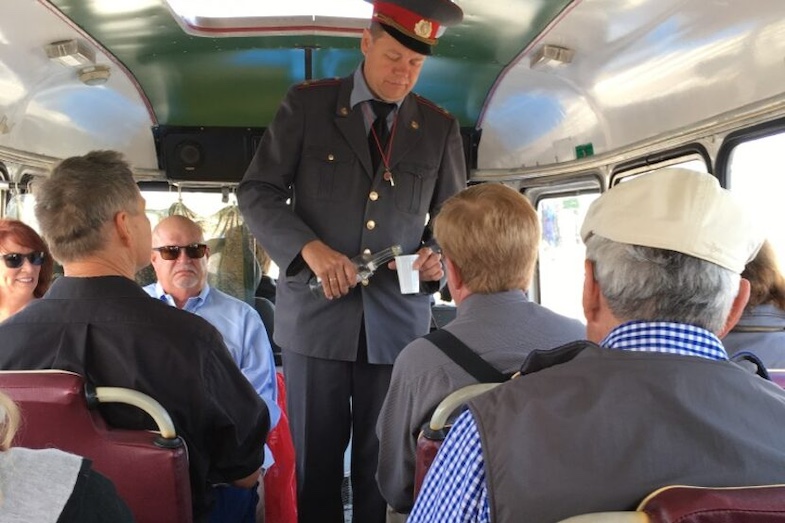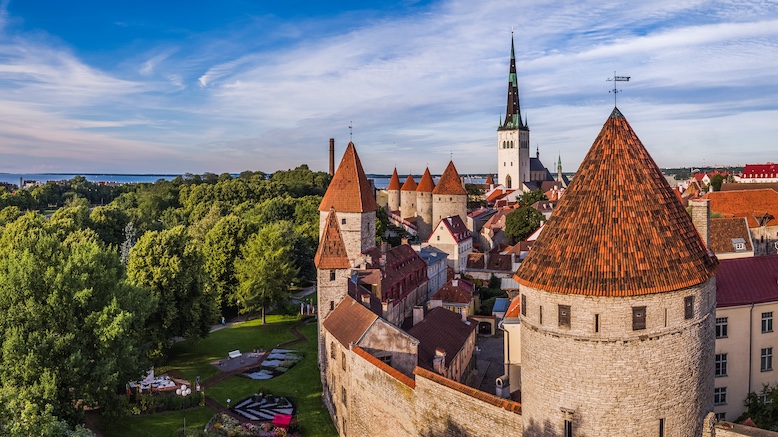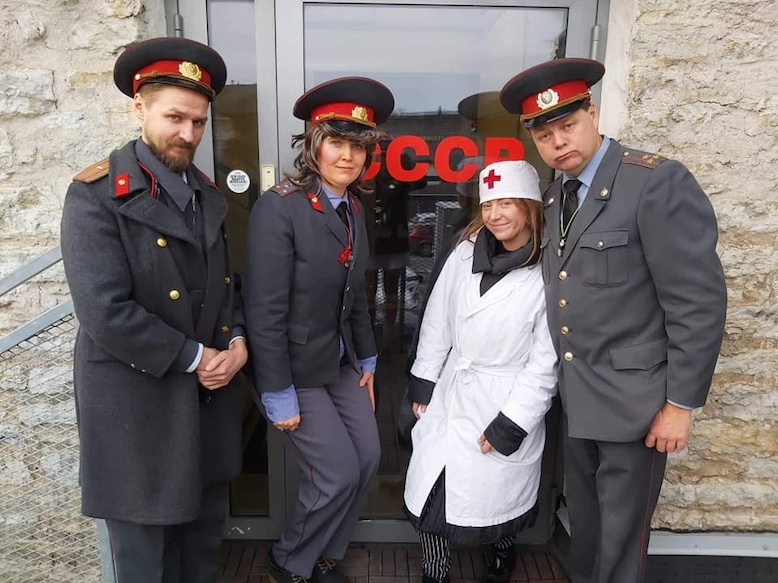
Western travelers in Tallinn, Estonia take a tour back in time to see what life was like under Soviet occupation. Tour guide Olavi Andla serves “Soviet morning coffee (aka vodka shots) to start the day. Photo by Sharon McDonnell
On my Soviet Flashback tour to Estonia’s capital of Tallinn a few years back, our guide, dressed in a Soviet uniform, regaled us with stories about the former Communist regime. His grandfather was incarcerated in Patarei Prison for having too many cows and horses. Olavi Andla told us the prison was near where we stood on the Baltic Sea shore. Driving past the Hotel Viru, we heard its rooms were once bugged by the KGB, the Russian secret service. Guests at check-in were asked their language, so an agent who spoke it could be assigned to eavesdrop. It was built in 1972 from “micro-concrete,” a special Soviet material composed of part microphones and part concrete, he joked. Ironically, today the Viru houses a KGB Museum, packed with artifacts and anecdotes.
As I stood in single file waiting to board our 1987 Communist-era van he went through my tote bag, fished out my lipstick and intoned “Testing, one, two, three.” Once on board, he served us “Soviet morning coffee” (vodka shots) accompanied by “Soviet napkins” (a toilet paper roll), and asked us to blow kisses to Leonid Brezhnev, the beloved leader.
Once in the past, a Russian man punched him in the nose, insulted by the uniform’s mockery of Soviet times. A tourist in his waiting tour group murmured to her companion, “Honey, I think our Soviet Flashback tour is starting,” he noted. His tour was a light-hearted romp in a Beatles-like Back in the USSR kind of way, not a dry recital of historical facts.
What a Difference a War Makes
Grim reality has intervened. Memories are fresh and painful in Estonia, which became independent from the USSR in 1991. “Since Russia attacked Ukraine, we don’t wear Soviet uniforms or use Soviet symbols anymore. We do the same program using neutral KGB spy costumes now,” says Andla, owner of Blue Drum Tours. “We hope the war ends and the Russian empire will collapse.” As for the Soviet-loving man who punched him, “He had Russkiy Mir,” he sighs.
It’s a reference to “Russian World,” a belief held by Vladimir Putin, that Russia is a civilization, not a mere country. The outlook allows the Kremlin to justify expansionist aggression like annexing Ukraine’s Crimea region and then declaring war on Ukraine on February 24, 2022.
Friends and Neighbors
Today, the flag of Ukraine flies next to the Estonian flag in Old Town Square, Tallinn’s main plaza, as it has since the war began. To mark the 1,000th day of the war, 1,000 candles, which spelled out “1,000,” were placed in the square, where a Gothic Town Hall still stands. “Since Russia was bombing all the utilities and the power grid in Ukraine, Estonians wanted to bring heat to Ukraine that night and were doing a fundraiser at the same time. Ukraine is defending all of us, so Estonia is a very strong supporter,” says Lisa Trei, a consultant to the Museum of Occupations and Freedom Vabamu in Tallinn, which opened in 2003. “They’re fighting for us; we have to do everything we can.”

Ukraine and Estonia flags appear side by side in Tallinn’s central plaza. One thousand candles cover the floor of the square commemorating Ukraine’s resistance to Russian aggression. Photo by Lisa Trei
Refuge From Putin
Over 50,000 refugees from Ukraine have received temporary protection in Estonia, whose population is only about 1.37 million, says Trei, a member of the Estonian Society of San Francisco and Stanford University writer/editor for 26 years, who now is retired. “The majority of Ukrainian children are studying in various schools across Estonia, where specially trained teachers and support staff were hired to teach them and help them adapt. In late 2022, a special school for Ukrainian pupils – the Freedom School – was established in Tallinn. It follows Estonia’s national curriculum but also teaches Ukrainian language and culture. One-third of the teachers are Ukrainian, mostly refugees,” she adds.
The Estonian language isn’t Slavic (unlike Poland, where thousands of refugees also fled) but akin to Finnish. “About 20% of the words are similar,” Trei says, adding that “Helsinki is a mere two-hour ferry ride from Tallinn.”
Kiev’s fight for survival revives the horrors of Soviet rule in Estonia, where about 20,000 people were imprisoned, murdered or deported to Siberia during the first Soviet occupation in 1941. The Soviets returned after the Nazi occupation collapsed in 1944, and about 30,000 more were deported. The northernmost, smallest and wealthiest of the three Baltic states, Estonia, a tiny nation of only 1.37 million people, is a tech hub. Ten Internet unicorns (companies valued at least $1 billion), including Skype, Bolt (a ride-hailing service) and Wise (a money-transfer service), were founded in Estonia. It was the world’s first country to allow voting online, back in 2005.

Inside Tallinn’s city wall is one of the best-preserved Old Towns in Northern Europe. Photo courtesy of Visit Tallinn
Tallinn, over 700 years old, has one of the best-preserved Old Towns in northern Europe. It is a UNESCO World Heritage Site with many 14th and 15th-century buildings. Standing in the Upper Town on Toomea Hill, I admired a wonderful view of conical, red-roofed towers, church steeples and medieval walls in the Old Town below, and the Baltic Sea beyond.
An exhibit about the astounding story of thousands of Estonians who fled the Soviets on small boats across the Atlantic Ocean to North and South America in 1945-51 was launched in Fall 2024 at the Vabamu Museum. Of the 47 known boats, which sailed without modern communications equipment and dodged Soviet ships, at least 17 arrived in the U.S., 11 in Canada, and seven in Argentina. “No one, except the Vikings, has come in such a small boat,” an astonished Canadian official said when the Astrid, carrying 29 people, docked in Quebec. The Estonians first fled Soviet rule in the 1940s to Sweden, which was neutral in World War II. After the Soviet Union pressured Sweden to deport them, many chose to leave.
Trei created Free Winds after winning a Fulbright Specialist fellowship for the project. “The tales of these 20th century Vikings, who risked all to live in freedom, is especially relevant today in the wake of Russia’s invasion of Ukraine, which has created millions of new refugees and once again threatens the security of Eastern Europe,” says Trei. “Even today, it’s largely unknown. It deserves a wider audience.” Her grandparents weren’t among the post-WWII refugees. They emigrated from Saaremaa, Estonia’s biggest island, known for uncrowded beaches, to New York City in the 1920s.

Lisa Trei at Free Winds Exhibit. Photo by Vabamu Museum
Free Winds is presently digital but will become a physical exhibit this summer. “It’s based on a book I translated, Forgotten Secret Journeys by Juri Vendla. My father started the research before another man took over. He later died, so I edited the English summary,” says Trei. It’s also part of her Tallinn University graduate program in Estonian Studies.
Trei is studying for her second Fulbright. Her first was for teaching journalism in 1993 at Tartu University in Tartu, Estonia (a 2024 European Capital of Culture). After that, she worked as the Wall Street Journal’s Baltic stringer, then as a reporter for Estonia’s first English-language newspaper, The Estonian Independent. She covered the breakup of the Soviet Union for Newsweek and major newspapers as a freelancer.
The Vabamu Museum is located on the edge of the Old Town. It includes a depiction of the KGB Prison Cells where citizens were tortured and interrogated by the Soviets. The city’s other Soviet-related sites include an outdoor exhibit of discarded Soviet statues in the park behind Maarjamae Palace. The old manor house was once the summer home of a Count from St. Petersburg, who lived there full-time after the 1917 Revolution. The mansion was Tallinn’s first hotel and restaurant from 1933 to 1937.

Curious to see inside Russian-occupied Ukraine? These Estonian tour guides are happy to show tourists what life was like when Russian Communists ruled Tallinn during the Cold War. Photo courtesy of Blue Drum Travel.
Lenin’s Head
Twenty-one Soviet monuments sculpted from 1945-90 include a giant head of Lenin. The Estonian History Museum placed the monuments behind the mansion. The 1,030-foot TV Tower built in 1980 became a symbol of Estonia’s independence after citizens defended it against the Soviets. At Patarei Prison, a museum will open by 2026.
“It is dangerous to think that the time of Stalins and Hitlers has passed,” Estonian President Lennart Meri said in 1999. In the words of philosopher George Santayana, “Those who cannot remember the past are doomed to repeat it.”![]()
Sharon McDonnell is a San Francisco travel, culture and food writer.

